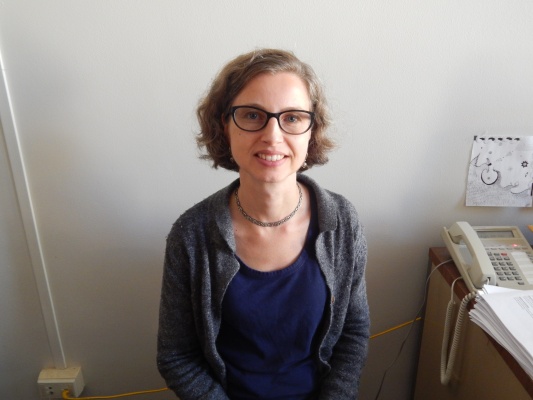Where Altruism Meets Academia
Karina Hogan, professor of Theology and Women’s Studies at Fordham University, poses for a photo in her office, 924 F on October 15th, 2015. Hogan is one of the professors that offers classes with the service learning option. (PHOTO BY LYDIA BENNER/ THE OBSERVER)
November 2, 2015
“Be men and women for others:”
As students of a Jesuit institution, we hear this phrase all of the time. We are encouraged to commit part of our time to the community—to give back. Many of us who have a history of volunteering wish to continue this aspect of our lives. Among the various programs Fordham offers students to fulfill these aspirations is integrated service learning.
According to Jeannine Hill-Fletcher, the faculty director of the service learning program, the service learning program connects academics to community outreach. It has existed, in a formal setting, at numerous universities around the country since the early 1980s. At Fordham, it began with the interdisciplinary seminar. This type of course allows students to apply community service to a class of their choice. Essentially, it is a partnership between a student, a professor and an outside organization where the student serves at least 30 hours during the semester and reflects upon his or her experience, via both writing and discussion with the professor. While this model of service effectively enhances a student’s learning of a particular subject, its benefits are limited to a single student.
In 2007, Sandra Lobo Jost, the director of the Dorothy Day Center, proposed another type of service learning. She had researched the programs offered at other universities across the country and found that courses in which every student is involved in the community had “a different set of benefits,” as Hill-Fletcher explained. They approached the deans of Fordham College at Lincoln Center (FCLC) and Fordham College at Rose Hill (FCRH), received their support and set out to develop these courses. In the spring of 2008, the first service learning integrated course was born.
Since then, approximately 35 service learning courses have been developed, with at least one or two new courses added each year. The subjects span several disciplines, including psychology, sociology and history. According to Hill-Fletcher, the program is “really interested in expanding to the sciences and math.”
Professor Karina Hogan of the theology department has an extensive history with service. She volunteered regularly during college and, after graduating, she dedicated a year entirely to service work—which ended up turning into two years. She said, “That really formed me as a person and…made me very committed to have [service] be part of my own life but also…to show [my students] what you can learn from that kind of experience.” She elected to teach service learning courses at Fordham.
“The first service learning course I developed was a course in the Hebrew prophets,” Hogan said. She had always wanted to teach Faith and Critical Reason – a required theology course of Fordham’s core curriculum. When the professor who had been teaching it left in the fall of 2013, she jumped at the opportunity.
Hogan believes that the most important aspect of service learning is “the change that happens in the student as a result of reflecting on the experience. [She thinks] that it’s very important, as you’re going through this experience of service, to step back and think about ‘What am I learning about myself and about my position of privilege in the world from this experience?’” The course includes weekly journal entries in which the student does exactly that.
“What happens as a result of the service learning is that the person becomes more committed to social change, to working…ultimately, becoming a man or woman for others. But that is not necessarily the main goal—it’s more the internal development of the self.” Hogan added, “The joy of teaching freshmen, especially in the first semester, is seeing how much they change and grow in those few months.”
The Dorothy Day Center facilitates connections between professors, students and organizations for service learning purposes. As specified by Carey Kasten, the interim faculty director of the service learning program, “One of the tenets of service learning [at Fordham] is that it’s a justice model and not a charity model…We’re not just using these organizations for our students but actually establishing a relationship with them that will go beyond a semester or beyond a certain student’s work.”
This semester, Hogan’s Faith and Critical Reason class is partnering with three non-profit organizations: Rauschenbusch Metro Ministries (RMM), Xavier Mission, and Nazareth Housing. The students will each complete at least (and, according to Hogan, most likely more than) 30 hours of service at their respective organizations.
Hannah Murphy, FCLC ’19, serves with RMM in the Page Turners program. Volunteers work with elementary school children in the afternoons to complete their homework after an hour of fun, which includes a trip to the park, board games and a snack. So far, Murphy enjoys it. “Everyone should have the chance to give back to their community,” she said.
Nik Rambob, FCLC ’19, chose to volunteer at Nazareth Housing, a shelter on the Lower East Side. He recommends service learning because several students are interesting in volunteering, and being in a specific course “gives them that extra push.”
Service learning prompts students to give back to the community, both for the purpose of serving others as well as applying the classroom material to the real world and vice versa. There are some things one can learn only by doing, and service learning courses provide a multitude of opportunities for an enriched learning experience.










